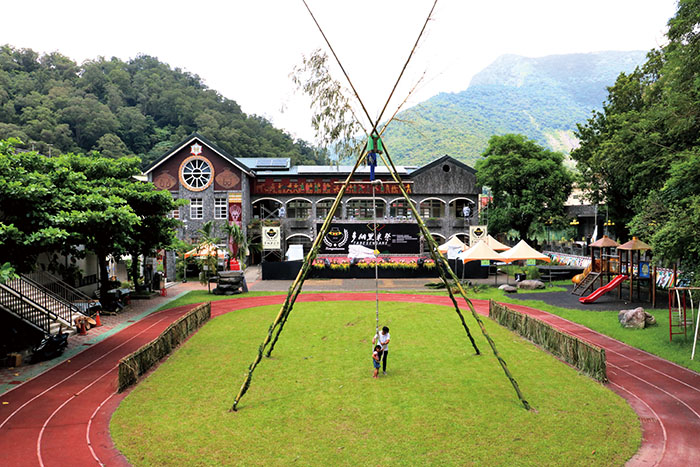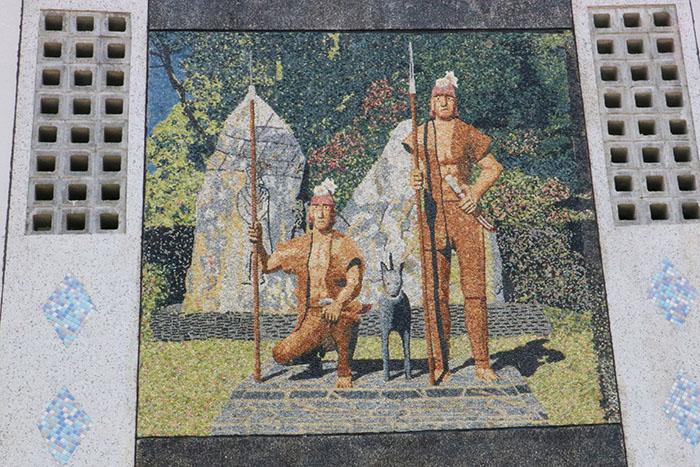Duona Elementary School in Maolin District/一脈相承的沙古塔忘─茂林多納國小
Duona Elementary School in Maolin District
◎English translation: Hou Ya-ting
◎Photos by Ye Yu-ci
Duona Elementary School treasures its indigenous Drekay (Rukai) heritage and makes the promotion and maintenance of the tribe's ancestral language and culture a priority. The school has carefully created a Drekay cultural ambiance throughout its campus. Entering via the main gate, on the right one sees mosaics which depict two hunters and a hound. According to legend, around 200 years ago, Drekay communities lived in various locations, but whenever hunters were chasing animals at what is now Duona, they noticed the hounds seemed reluctant to leave this swamp. This convinced the hunters the site was an ideal place to inhabit, and their chieftain consented to relocating the tribe to Duona's current location. Later on, they were joined by other clans, forming today's Duona community. In the Drekay language, Duona is called Kungadavane.

Traditional buildings here are made of stone slabs, and this type of architecture is reflected in the choice of building materials around the campus. The review stand, walls, and school facade all feature stone slabs. In the past, Duona's people cut stone slabs near the village's hot springs. Moving heavy slabs and using them to assemble a building required collaboration. Such structures are therefore symbols of unity and cooperation.
Entering the campus, visitors can see stories about Duona, told in the form of tribal totems engraved upon stone-slab walls. The Cultural Exhibition Hall is located on the second floor, and this is where pupils study their ancestral tongue. At the hall's entrance there is a board inscribed with motifs of hundred-pacer snakes and ceramic pots. It is hoped these images instill in Duona's children the importance of not forgetting their roots. For outsiders interested in the lifestyles of the villagers' ancestors, the Cultural Exhibition Hall is an excellent place to view tools, attire, handicrafts, and historic photos.
The Drekay express their mythology in the form of iconic totems and paintings, and these can be seen around the campus. One noticeable place to look is the outside wall of the kindergarten affiliated with the school. Drekay spelling symbols and animated pictures, it is hoped, will encourage young pupils' interest in their mother tongue.
The school playground is the main venue of the Tapakadrawane Festival, the most important annual event for the Drekay. This festival takes place in the middle of July, and many Drekay who study or work in other parts of Taiwan return home for the event.
Legend has it that Tapakadrawane originates from the River God seeing a mother who was too busy to plant black kernel rice and take care of her child at the same time. The god therefore kindly offered to look after her child until the child grew into an adult, promising to eventually send the youngster back home on one condition: In return, the mother must offer part of her crop to the god.
When the child returned to the tribe, the inhabitants organized the Tapakadrawane Festival as a way to express their gratitude to the god. Since then, the festival has evolved into a more general celebration of abundance harvests and appreciation for those divinities who bless crops. This year's Tapakadrawane Festival, in addition to its traditional function, embraced both local residents and visitors by hosting a series of cultural events, such as garlanding wreaths, grinding millet with a wooden mortar, playing on swings, trap games, archery, and sawing wood, in order to promote Drekay culture.
A visit to charming Duona Elementary School –whether your aim is pleasant communication with the Drekay, observing Drekay culture, or appreciating beautiful scenery –is sure to make a deep impression on you.
一脈相承的沙古塔忘─茂林多納國小
◎文、攝影/葉郁琪
 為保存珍貴的多納魯凱語文化資產,多納國小讓孩子們在傳統文化氛圍中成長,培養對自身根源的重視與珍惜。學校大門口右側牆上的馬賽克拼貼壁畫,畫中是兩位獵人與一隻獵狗。相傳兩百多年前各家族散居在不同山區,獵人多次帶獵狗到多納部落現居地打獵,要回家時獵狗總是不願離去,獵人覺得此處沼澤地適合居住,說服頭目將族人遷移至此,而後加入更多家族,形成現在的多納部落(Kungadavane)。
為保存珍貴的多納魯凱語文化資產,多納國小讓孩子們在傳統文化氛圍中成長,培養對自身根源的重視與珍惜。學校大門口右側牆上的馬賽克拼貼壁畫,畫中是兩位獵人與一隻獵狗。相傳兩百多年前各家族散居在不同山區,獵人多次帶獵狗到多納部落現居地打獵,要回家時獵狗總是不願離去,獵人覺得此處沼澤地適合居住,說服頭目將族人遷移至此,而後加入更多家族,形成現在的多納部落(Kungadavane)。
走進校園內,隨處可見石板造景,包括司令台、圍牆,連校舍外牆都是石板拼貼。石板屋為魯凱族代表建築特色,多納部落居民以往會到溫泉溪尋找適合建築的石材,從切割、搬運到建造,都需要部落眾人齊力合作,因此石板屋被視為多納魯凱團結合作的精神象徵。
由石板堆砌成的圍牆,鑲上一塊塊刻有傳統圖騰的浮雕,安靜堅定敘述著多納的故事,校舍二樓設有文物展示館,是孩子上母語課的地點,門口懸掛的匾額圍繞百步蛇與陶壺,並寫著「沙古塔忘」四字,為「多納人」之意,就像母親溫暖地叮嚀,不管社會如何變遷,都不要忘記自己的根。館內陳設多納先人使用的器具、服飾、工藝等,還有許多珍貴的歷史照片,呈現先人生活的風貌。
校園內也有多處彩繪與石板元素形成對比,內容包含神話故事與象徵圖騰,附設幼兒園外,有一整面族語教學彩繪,生動圖案加上族語拼音,讓孩子輕鬆無礙地運用母語。學校操場正是黑米祭(Tapakadrawane)主要場地,在每年七月中旬舉辦,是部落最隆重熱鬧的盛事,也是大團圓的日子,在外地求學、工作的族人都會回鄉共襄盛舉。
關於黑米祭由來,據說是水神不忍一名婦女忙於耕種黑米,無暇照顧孩子,允諾扶養孩子成人後再送回,而婦女須將部分收成獻予祂。十幾年後,孩子果然長成英勇少年回到部落,族人為酬謝水神所舉行,之後演進為感謝神靈庇佑作物生長,祈求來年豐收富足。現在的黑米祭,除傳統祭祀活動外,加入許多新嘗試,包含編花圈、搗小米、盪鞦韆、設陷阱等傳統文化體驗,以及射箭、鋸木等技藝競賽,不只讓部落族人參與,更歡迎旅客同歡,希望將多納魯凱族文化發揚光大。
有機會一訪多納國小,請帶著一顆尊重且富有彈性的心,欣賞這處小而美的地方,也可以禮貌友善地與當地魯凱族人相談,探索美景背後的深遠文化意涵,將會有意想不到的收穫。